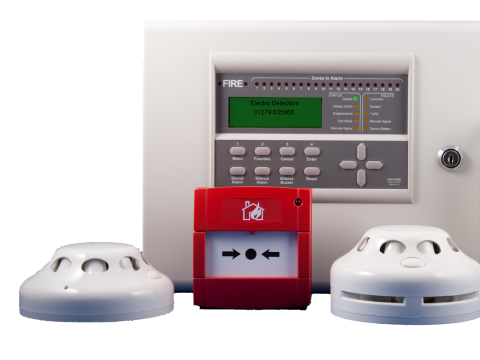Fire alarm systems rely on detectors (sometimes called “fire alarm sensors” or “fire alarm initiating devices”) to identify early signs of a possible blaze. Detectors are commonly categorized by:
- Detection Principle: Smoke, Heat, or Flame
- Zone of Detection: Spot (point), Linear, or Volumetric
- Method of Signal Transmission: Wired or Wireless, Threshold or Analog, Addressable or Non-Addressable
Below, we’ll outline the various detectors used in modern fire alarm setups, highlighting each type’s unique attributes, strengths, and installation considerations.
Fire Detectors by Detection Principle
1. Smoke Detectors
Smoke is often the first sign of a developing fire, making smoke detectors the most frequently used sensors. They commonly appear in two subtypes:
- Optical-Electronic (Photoelectric)
- Ionization
Optical-Electronic Smoke Detectors
- Infrared (IR) Beam inside a smoke chamber detects any change in light scatter.
- Widely deployed due to reliability and lower false alarm rates compared to older ionization models.
Ionization Smoke Detectors
- Ionization chamber with a small radioactive source detects microscopic smoke particles.
- Highly sensitive to fast-flaming fires, though they’ve become less prevalent due to disposal concerns and more frequent false alarms in certain scenarios.
2. Heat Detectors
Heat detectors respond to elevated temperatures. They’re typically categorized as:
- Fixed-Temperature (Maximum): Activates at a set threshold (e.g., 135–160°F).
- Rate-of-Rise (Differential): Monitors how quickly temperature changes over a short period.
- Combination (Max-Differential): Combines both triggers (threshold temperature and rapid increase).
Heat detectors are often used in dusty or harsh environments where smoke detectors might cause false alarms or get clogged with debris.
3. Flame Detectors
Flame sensors detect the characteristic spectra (infrared, ultraviolet, or visible light) produced by an open flame. Because they’re sensitive to direct line-of-sight fire radiation, they are used less commonly in standard buildings—more so in specialized industrial or high-hazard applications (chemical plants, fuel storage, etc.).
Zone of Detection: Point, Linear, and Volumetric
1. Point (Spot) Detectors
- Location-Specific Detection: Monitors temperature or smoke only at (or near) the spot where the detector is installed.
- Coverage Area: Defined by building codes such as NFPA 72 (in the US) or local equivalents, factoring in ceiling height, room size, and detector spacing.
- Ceiling Height Constraints: Often recommended for ceilings up to ~30–40 ft (9–12 m). Beyond that, efficiency may decline.
2. Linear Detectors
- Extended Range: Ideal for large or tall spaces (warehouses, gymnasiums).
- Examples:
- Beam Smoke Detectors: A transmitter and receiver (or a transmitter with a reflector) create an IR beam across the monitored area. Any significant interruption or obscuration (due to smoke) triggers an alarm.
- Linear Heat Sensors: Often a heat-sensing cable that changes electrical properties when exposed to critical temperatures. Useful for tunnels, cable trays, and other narrow/long installations.
3. Volumetric (Flame) Detectors
- Primarily associated with flame sensors, covering a 3D (volumetric) space. These detect radiation from open flames within their field of view.
Transmission & Signal Types
1. Wired vs. Wireless
Wired:
- Most common for fire alarm setups.
- Lower cost and robust reliability.
- Cabling is essential, which may pose aesthetic or logistical challenges in certain buildings.
Wireless:
- Less common, more expensive.
- Offers simplicity in installation.
- Must meet strict fire-safety regulations for reliability and battery life.
2. Threshold (Conventional) vs. Analog
Threshold (Conventional) Detectors:
- Simple and cost-effective.
- Switch from high to low resistance (or vice versa) upon reaching a fixed value.
- Provide only basic “alarm” or “no alarm” states.
Analog (Analog-Addressable) Detectors:
- Continuously measure environmental parameters (e.g., smoke density, temperature trend).
- Better at early fire detection and reducing false alarms.
- Typically cost more but offer higher reliability and data granularity.
3. Addressable vs. Non-Addressable
Addressable:
- Each detector has a unique digital ID.
- The control panel identifies the exact sensor in alarm or fault, improving response times.
- Often can replace multiple non-addressable units, reducing total installation cost in large buildings.
Non-Addressable (Conventional):
- Group detectors into zones; the panel only knows which zone alarmed, not the specific sensor.
- More affordable upfront, but less precise in location reporting.
Special Considerations & Less-Common Types
- Aspirating Detectors:
- Constantly sample air through a network of pipes; extremely sensitive for clean environments (like data centers).
- Duct Detectors:
- Positioned in HVAC ducts to detect smoke circulating in the ventilation.
- Standalone (Autonomous) Detectors:
- Battery-powered, typically used in small homes or localized coverage. Often can’t be networked with a central panel.
Conclusion
Choosing the right fire alarm detectors depends on building characteristics, types of fire risks, and code requirements:
- Smoke Detectors: Best for early detection in standard office or residential settings with synthetic materials.
- Heat Detectors: Suited for high-dust or high-ceiling areas prone to false alarms from smoke sensors.
- Flame Detectors: Specialized for open-flame detection, typically in industrial or high-hazard sites.
- Line (Beam) Sensors: Effective in large open areas, potentially lowering total cost by reducing the number of point detectors.
- Addressable devices provide more granular data and rapid incident localization, especially vital in bigger complexes.
No single sensor type addresses all scenarios. Often a blend of smoke, heat, and possibly flame—plus the right zone setup (point or linear)—achieves comprehensive coverage. For personalized recommendations and high-quality fire detection products, consult with safsale.com, where our experts can guide you on code compliance, cost optimization, and top-tier system design.

